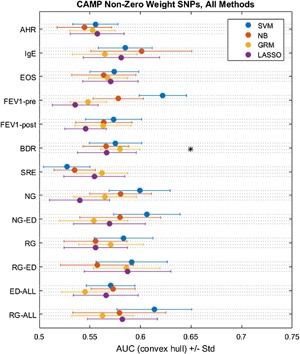Figure 2.

Asthma phenotypes predicted by four methods, using a reduced set of SNPs predicted to be of greater functional relevance. SVM, support‐vector machine; NB, naïve Bayes; GRM, genetic relatedness matrix; LASSO, least absolute shrinkage and selection operator regression; AHR, airway hyperresponsiveness; EOS, eosinophil count; Pre‐FEV1, pre‐bronchodilator forced expiratory volume in 1 sec; Post‐FEV1, post‐bronchodilator forced expiratory volume in 1 sec; BDR, bronchodilator response ((Post‐FEV1 − Pre‐FEV1)/Pre‐FEV1); SRE, steroid responsiveness endophenotype; NG, normal FEV1 growth (without early decline); NG‐ED, normal FEV1 growth with early decline; RG, reduced FEV1 growth (without early decline); RG‐ED, reduced FEV1 growth with early decline; ED All, early FEV1 decline (with normal growth or with reduced growth); RG All, reduced FEV1 growth (with or without early decline). *Indicate prediction meeting statistical significance for greater than random performance (AUC 0.50; p < 0.05, permutation test).
